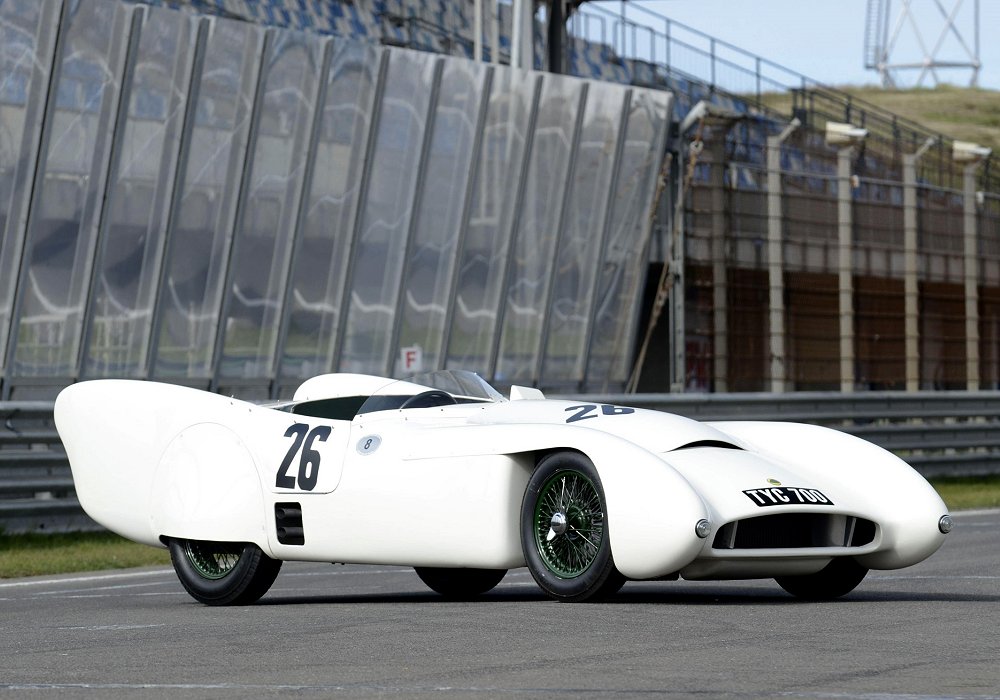Description
The Lotus Mark VIII, completed in 1954, was a pivotal car in the early history of Lotus and represented Colin Chapman’s first true step toward building a fully professional racing machine. It followed the experimental Mark VI sports-racer and introduced a level of aerodynamic design and structural sophistication that would define the company’s engineering philosophy for decades to come. The Mark VIII was not only a competitive racer in its own right but also a technical landmark — the first Lotus to feature the now-famous spaceframe chassis and the first to carry the distinctive, streamlined look that would characterise many of Chapman’s later designs.
The Mark VIII’s creation was driven by Chapman’s belief that the key to speed was not brute power but lightness, rigidity, and aerodynamic efficiency. Its tubular spaceframe chassis was both lighter and stronger than the ladder-frame design used in the Mark VI, weighing just over 25 kilograms but offering excellent torsional stiffness. This layout became a hallmark of Lotus engineering and would be refined in almost every subsequent competition model. The bodywork, designed by Frank Costin — an aerodynamicist who had worked for de Havilland — was shaped with great attention to reducing drag and improving stability. The result was a low, elegant body with a smooth, tapering tail and enclosed rear wheels, achieving a coefficient of drag far ahead of most sports cars of the time.
The powerplant was typically a 1,498 cc MG XPAG engine, tuned to produce around 85 to 100 horsepower, depending on the specification. The engine was mounted well back in the chassis for improved weight distribution and mated to a close-ratio gearbox. With a total weight of around 450 kilograms, the Mark VIII delivered remarkable performance for its displacement, capable of speeds exceeding 125 mph — a figure exceptional for a 1.5-litre car in the mid-1950s. Braking was by drums on all four wheels, and the car used independent front suspension with wishbones and coil springs, while the rear featured a live axle with trailing arms and a Panhard rod.
The Mark VIII made its competition debut at Silverstone in 1954, where it immediately demonstrated its potential. Chapman himself drove the car with great success, competing against much larger and more powerful machinery and proving that his theories of lightweight construction and aerodynamic efficiency were correct. Over the course of the season, the Mark VIII achieved numerous class victories and strong overall finishes, often outperforming cars from established marques such as Jaguar, Aston Martin, and Frazer Nash. Its combination of speed, handling, and balance made it a favourite among privateer racers, who admired its predictability and adjustability on the limit.
The Mark VIII also represented a shift in Lotus’s ambitions. Unlike the earlier Mark VI, which had been offered as a kit car, the Mark VIII was intended primarily as a pure racing machine, reflecting Chapman’s growing confidence and the company’s move toward professional competition. Its design principles would directly influence the later Mark IX and Mark X, which refined its aerodynamics and packaging for endurance events such as Le Mans.
In aesthetic terms, the Mark VIII was one of the first Lotus cars to establish the brand’s visual identity. The sleek, low-slung shape and long, tapering nose gave it a purposeful but elegant appearance, and its minimalist cockpit reflected Chapman’s commitment to function over ornament. It was designed around the driver, with excellent visibility, light controls, and a seating position that placed the driver low within the chassis for optimal balance.
Today, the Lotus Mark VIII is remembered as one of the most important early Lotus models — a car that set the template for the company’s engineering approach for years to come. Its blend of aerodynamic refinement, lightweight construction, and mechanical simplicity embodied Chapman’s guiding philosophy that “adding power makes you faster on the straights; subtracting weight makes you faster everywhere.” Only a small number of Mark VIIIs were built, and surviving examples are treasured by collectors for their historical importance and rarity.
The Mark VIII was the car that truly defined Lotus as a constructor of advanced, purpose-built racing machines. It marked the beginning of the brand’s ascent from small-scale sports-car engineering to international racing prominence, setting the stage for the innovations that would eventually lead Lotus to Formula One glory.
